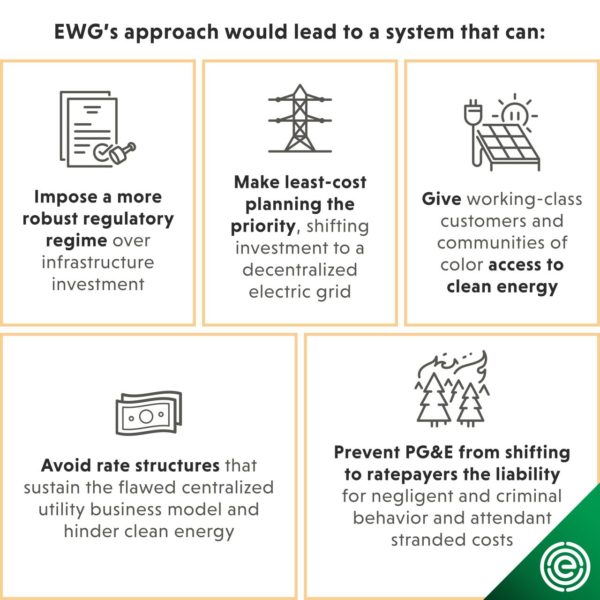Environmental Working Group (EWG) is calling for major California utility Pacific Gas and Electric (PG&E) to change course, and begin supporting distributed rooftop solar and energy efficiency programs in pursuit of a safer, more resilient, more environmentally conscious, and cheaper electric grid.
EWG said that for nearly a decade, PG&E has funded lobbying group Edison Electric to quash energy efficiency and rooftop solar programs, instead preserving the utility’s ability to control the market and charge high rates for vast amounts of centralized power. Most recently, the utility, through its lobbyists, has supported the battle against net metering, a key structure that supports the value of customer-sited solar panels.
EWG suggested a few high-level changes that could help rein in PG&E’s practices, bringing the utility closer to its mandated goal of providing reasonably priced, reliable energy for years to come. The group calls for a more robust regulatory scheme over infrastructure investment, making least-cost, decentralized grid planning a priority, and providing working-class customers access to clean energy. It also calls for eliminating rate structures that sustain the centralized utility business model, which it said hinders clean energy development. EWG also said PG&E should be barred from shifting liability onto ratepayers related to negligent behavior, like the neglect of high-powered transmission lines that led to widespread wildfires in the state.

In contrast with PG&E’s claim that customer-owned rooftop solar is increasing electric bills, the argument conspicuously ignores the massive buildout of its transmission system that has cost $9 billion over the past decade, 70% of which had no regulatory approval. EWG said the nearly $3 billion electric utility transmission investment in 2020 will equate to $10 billion in ratepayer costs over the lifetime of the investment.
California electric utilities have among the highest profit margins in the country. The loosely regulated buildout of centralized transmission is a boon to monopoly utilities, which need to create capital expenditures to justify rate increases in the ratemaking process.
Despite numerous analyses showing massive cost savings by switching to a decentralized model, efforts to sustain the old grid remain. In 2018, the California Independent System Operator (CAISO), which oversees the state’s transmission system, estimated customer solar and energy efficiency investments avoided $2.6 billion in transmission and distribution system upgrades.
In addition, Vibrant Clean Energy released a study showing that, by 2050, a decentralized grid, with solar plus storage, energy efficiency and other measures to balance supply and demand, would save $120 billion, compared to a centralized, renewables-dominated electric grid.

Image: Wikimedia Commons
Image: Wikimedia Commons
EWG released a four-part investigative series into the history of PG&E and its failure to adequately serve Californians reliable, clean, and reasonably priced electricity. Part one focuses on the history of flawed energy investments, part two on PG&E’s profit-boosting efforts at the expense of ratepayers, part three on the billions in bailouts for misguided power planning, and part four on an equitable clean energy plan for overhauling PG&E.
EWG president and co-founder Ken Cook said, “PG&E is crushing Californians in their wallets, it’s killing Californians in devastating wildfires that are the direct result of its misguided energy planning, and it’s harming the planet by adding to the climate crisis with a rigid addiction to fossil fuels. We hope this investigation will finally spur the state to rein in the out-of-control utility and force real reform within the company. Long-suffering Californians, desperate for relief from ever-increasing energy bills, thanks to PG&E, deserve no less.”
This content is protected by copyright and may not be reused. If you want to cooperate with us and would like to reuse some of our content, please contact: editors@pv-magazine.com.









Since when does EWG know anything about power system operations? At least the Sierra Club has 50 years invested in this issue. At one point the EWG paper argues that PG&E shouldn’t be investing in distribution and transmission systems because electricity consumption is flat. Meanwhile, California is targeting 2045 to be carbon neutral. Between population growth, higher rates of instate self-sufficiency, EV load, Desal load and the electrification of process and space heating California will likely need to quadruple in-state electricity generation over the next 23 years – i.e going from 133 TWh per year to around 500 TWh. This is something like 250 to 350 GW of solar. Go to Google Maps and type in Desert Sunlight – we’ll need well over 500 of those.
Who’s kidding who? California’s in-state generation is going to come from places like San Bernardino, Imperial, Tulare, Kern, and so on – Cheap sundrenched land. Not only is power generation going to be centralized – we’re going to see power complexes that dwarf Diablo Canyon. China has the right idea… Go to the Gobi and build hundreds of GW. We have plenty of deserts to farm in California.
California has historically imported around 33% of its power from neighboring states. This is getting harder to do now that the Pacific Northwest has become a summer peaking system and importing coal from the Four Corner states has lost its social license. A lot of these states also have carbon-neutral goals so they won’t necessarily have excess power to export. I know my utility won’t. Think about it… Utilities will need to displace gas for space heating and cooking as well as gasoline for driving… Don’t forget about the 3000 TWh of industrial heat (US total) to boot.
The only thing EWG is good at is running scare campaigns against things like cell phone radiation, sunscreen, lipstick and vaccines. EWG is the TMZ of environmental organizations. It looks like these guys are doing the bidding of trial lawyers looking to file class-action suits. These are the same sorts of trial lawyers who paid Andrew Wakefield £400,000 to write the now-infamous paper in the Lancet that’s led to an outrageous amount of pain and suffering.
It’s really strange to read this stuff here.